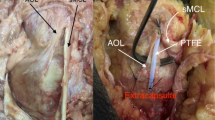Abstract
The purpose of this study was to determine the impact of axial traction during acquisition of direct magnetic resonance (MR) arthrography examination of the knee in terms of joint space width and amount of contrast material between the cartilage surfaces. Direct knee MR arthrography was performed in 11 patients on a 3-T MR imaging unit using a T1-weighted isotropic gradient echo sequence in a coronal plane with and without axial traction of 15 kg. Joint space widths were measured at the level of the medial and the lateral femorotibial joint with and without traction. The amount of contrast material in the medial and lateral femorotibial joint was assessed independently by two musculoskeletal radiologists in a semiquantitative manner using three grades (‘absence of surface visualization, ‘partial surface visualization or ‘complete surface visualization’). With traction, joint space width increased significantly at the lateral femorotibial compartment (mean = 0.55 mm, p = 0.0105) and at the medial femorotibial compartment (mean = 0.4 mm, p = 0.0124). There was a trend towards an increased amount of contrast material in the femorotibial compartment with axial traction. Direct MR arthrography of the knee with axial traction showed a slight and significant increase of the width of the femorotibial compartment with a trend towards more contrast material between the articular cartilage surfaces.





Similar content being viewed by others
References
Applegate GR, Flannigan BD, Tolin BS, Fox JM, Del Pizzo W (1993) MR diagnosis of recurrent tears in the knee: value of intraarticular contrast material. AJR Am J Roentgenol 161:821–825
Magee T, Shapiro M, Rodriguez J, Williams D (2003) MR arthrography of postoperative knee: for which patients is it useful? Radiology 229:159–163
White LM, Schweitzer ME, Weishaupt D, Kramer J, Davis A, Marks PH (2002) Diagnosis of recurrent meniscal tears: prospective evaluation of conventional MR imaging, indirect MR arthrography, and direct MR arthrography. Radiology 222:421–429
Brossmann J, Preidler KW, Daenen B, Pedowitz RA, Andresen R, Clopton P, Trudell D, Pathria M, Resnick D (1996) Imaging of osseous and cartilaginous intraarticular bodies in the knee: comparison of MR imaging and MR arthrography with CT and CT arthrography in cadavers. Radiology 200:509–517
Gagliardi JA, Chung EM, Chandnani VP, Kesling KL, Christensen KP, Null RN, Radvany MG, Hansen MF (1994) Detection and staging of chondromalacia patellae: relative efficacies of conventional MR imaging, MR arthrography, and CT arthrography. AJR Am J Roentgenol 163:629–636
Harman M, Ipeksoy U, Dogan A, Arslan H, Etlik O (2003) MR arthrography in chondromalacia patellae diagnosis on a low-field open magnet system. Clin Imaging 27:194–199
Kramer J, Stiglbauer R, Engel A, Prayer L, Imhof H (1992) MR contrast arthrography (MRA) in osteochondrosis dissecans. J Comput Assist Tomogr 16:254–260
McCauley TR, Elfar A, Moore A, Haims AH, Jokl P, Lynch JK, Ruwe PA, Katz LD (2003) MR arthrography of anterior cruciate ligament reconstruction grafts. AJR Am J Roentgenol 181:1217–1223
Sampson T (2005) The lateral approach. In: Bryrd J (ed) Operative hip arthroscopy. Springer, New York, pp 129–144
Chan KK, Muldoon KA, Yeh L, Boutin R, Pedowitz R, Skaf A, Trudell DJ, Resnick D (1999) Superior labral anteroposterior lesions: MR arthrography with arm traction. AJR Am J Roentgenol 173:1117–1122
Llopis E, Cerezal L, Kassarjian A, Higueras V, Fernandez E (2008) Direct MR arthrography of the hip with leg traction: feasibility for assessing articular cartilage. AJR Am J Roentgenol 190:1124–1128
Nishii T, Nakanishi K, Sugano N, Naito H, Tamura S, Ochi T (1996) Acetabular labral tears: contrast-enhanced MR imaging under continuous leg traction. Skeletal Radiol 25:349–356
Landis JR, Koch GG (1977) An application of hierarchical kappa-type statistics in the assessment of majority agreement among multiple observers. Biometrics 33:363–374
Author information
Authors and Affiliations
Corresponding author
Rights and permissions
About this article
Cite this article
Palhais, N.S., Guntern, D., Kagel, A. et al. Direct magnetic resonance arthrography of the knee: utility of axial traction. Eur Radiol 19, 2225–2231 (2009). https://doi.org/10.1007/s00330-009-1389-3
Received:
Revised:
Accepted:
Published:
Issue Date:
DOI: https://doi.org/10.1007/s00330-009-1389-3




